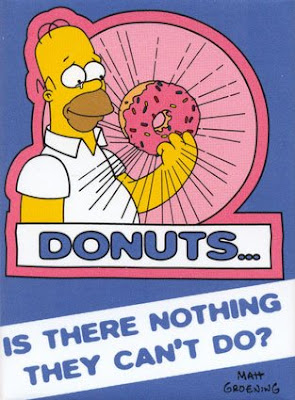Mmmm... Donuts... The Sequel

% Simpson Tide, Act one. Homer is standing in chains before
% a court composed completely of immense, talking doughnuts
% of various shapes, colors, and flavors. The judge,
% assumably, is a white doughnut seated at a table across
% from him.
White Doughnut: Homer Simpson, you stand accused of eating
half the population of the planet of the doughnuts!
[The doughnut onlookers give out a mass yell of protest.]
Pink Doughnut: As Homer's defense attorney, I feel we should
be mercifu... hey! Did you just take a bite out of me?
Homer: Uh... maybe.

 When we last left the Krispy Kreme story, we saw greater activity in the substantia nigra and locus coeruleus while the characters viewed doughnuts (but not hex nuts) when they were hungry. The backstory revealed activation in the amygdala and posterior cingulate under the same conditions. The experiment by Mohanty et al. (2008) did have a greater purpose, however:
When we last left the Krispy Kreme story, we saw greater activity in the substantia nigra and locus coeruleus while the characters viewed doughnuts (but not hex nuts) when they were hungry. The backstory revealed activation in the amygdala and posterior cingulate under the same conditions. The experiment by Mohanty et al. (2008) did have a greater purpose, however:...to explore the motivational modulation of the spatial attention network in a task that manipulated the motivational properties of the attentional target, the motivational state of the participant and the location of the target. To that end, we used a covert attentional shift paradigm to examine the effect of alterations in motivational states (hunger and satiety) on attentional biasing to peripheral locations where motivationally relevant (food) and irrelevant (tools) targets were expected to appear.

Figure 1 (Mohanty et al., 2008). Stimuli and timelines used in the experimental task. Participants were instructed to respond to the onset of peripherally presented targets (donuts or hex-nuts) and foils (danishes or screws) by pressing the right and left button respectively. A cue that preceded target onset by 200, 400, or 800 ms indicated that the target would appear on the side indicated by the directional cue (valid trial), on the opposite side (invalid trial), and on either side of the nondirectional cues (nondirectional trial). Each participant was imaged as they performed the task in two experimental sessions, once while hungry and once while satiated on donuts.

After determining the obvious effects of hunger on brain activity to peripherally-presented donut targets, the investigators
...examined brain regions that mediate motivational modulation of anticipatory spatial attention in a material-specific manner (level 2). For this purpose, another model was estimated to examine brain areas whose activity was associated significantly with cue benefit scores.The experiment used a Posnerian task to examine covert shifts of attention. Prior to presentation of the dough/nut targets1, the participants viewed cues that correctly predicted the side of the target (valid cues), predicted the wrong side (invalid cues), or neither (nondirectional cues). The cue benefit score was the reaction time advantage obtained with valid compared to neutral cues.
What did the fMRI results show?

Figure 4b (Mohanty et al., 2008). Hunger altered the correlation between neural activity in the attentional network and the speed of attentional shifts differentially to food versus tool targets. There was a stronger positive correlation of neural activity with attentional shifts to food targets when hungry than when satiated, whereas an inverse pattern was seen for tools. Bar plots show mean parametric estimates (±1 SEM) of the correlation between neural activity in the PC [posterior cingulate] and PPC [posterior parietal cortex] and speed of attentional shifts to food and tool stimuli in hungry and satiated condition.
According to the authors, these results demonstrate
the interactive role of posterior parietal and cingulate cortices in integrating motivational information with spatial attention, a process that is critical for selective allocation of attentional resources in an environment where target position and relevance can change rapidly.
Footnote
1 FOOD and TOOLS were specified as the targets in separate blocks of trials.
Reference
 Mohanty A, Gitelman DR, Small DM, Mesulam MM. (2008). The Spatial Attention Network Interacts with Limbic and Monoaminergic Systems to Modulate Motivation-Induced Attention Shifts. Cerebral Cortex DOI: 10.1093/cercor/bhn021. Feb 27; [Epub ahead of print].
Mohanty A, Gitelman DR, Small DM, Mesulam MM. (2008). The Spatial Attention Network Interacts with Limbic and Monoaminergic Systems to Modulate Motivation-Induced Attention Shifts. Cerebral Cortex DOI: 10.1093/cercor/bhn021. Feb 27; [Epub ahead of print].MY BUTT DOES NOT DESERVE A WEB SITE
Subscribe to Post Comments [Atom]













0 Comments:
Post a Comment
<< Home